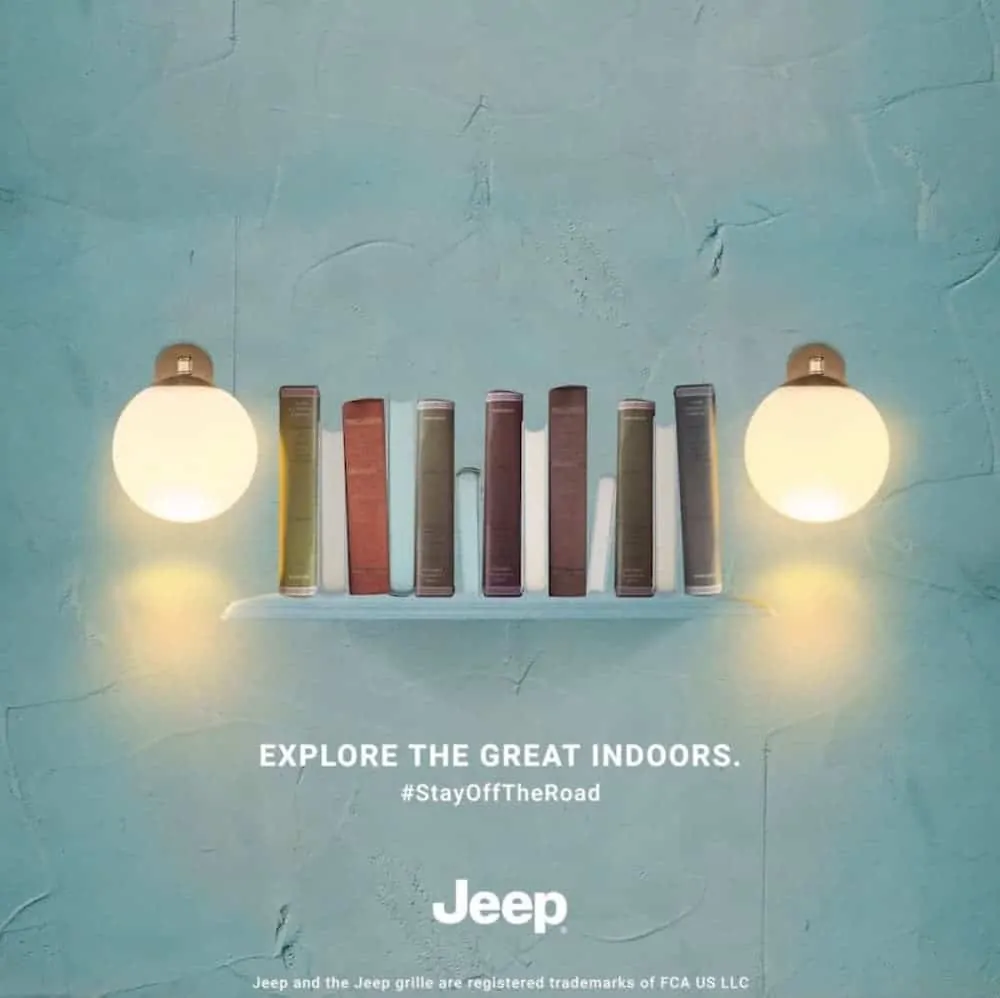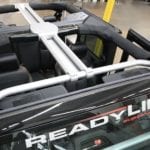Some might argue that there’s a fine line between advertising and art––others might decry that there’s a massive line between the two and that never shall they meet. Personally, I’d say that great advertising can come to the edge of that line, even cross the threshold and become something more than just another commercial. This is rare, perhaps almost miraculously rare, but sometimes you see an ad that surpasses the pallid limitations of routine advertising and becomes something greater than what you expected.
Such is the nature of the latest Jeep ad campaign (if we really want to call it that) and its message of StayOffTheRoad (they use it in hashtag form, but that seems silly here). Why is it so powerful? Why is this message actually worth conveying, and should we care that Jeep is rolling it out as their public image to the world? In my opinion, one look is all it takes to see the boldness and depth of this message and their ad campaign––a brilliant visual play on the iconic front grille of the Jeep Wrangler that stands to remind us all of what’s most important: each other.
The Simplicity of Design
As a writer, I’m obligated to give you words. It’s not only my profession, my vocation, but how I have chosen to communicate with the world. There is, of course, the old saying that “A picture is worth a thousand words,” and I have often argued with that idea because of the fluidity and obscurity of language––allowing a simple phrase to have numerous meanings. And yet, here, I cannot deny that we can see a picture that is, in fact, worth more words than I have to spare.
The above image, in its simplicity and thoughtful design, makes an immediate and perfect impact. Even if those words were removed, if it was devoid of the Jeep name, slogan, and hashtag, the image itself would offer all the meaning we need. It’s not universal––someone that has never seen the front of a Jeep Wrangler would get nothing from it. But, for its audience, it’s damn-near primal in the perfection of its form language.
As soon as you see it, the subject becomes clear. The words below provide additional context, ensuring we understand the full depth of its message, but they are not strictly essential. This is where an advertisement meets the line of art and becomes something truly worthwhile and memorable. But there’s more.
This is an even stronger image, which now surpasses the initial brilliance of the concept and takes things to the next level: visual storytelling. With the bare minimum of imagery, much of the picture is solid black or barely visible, and we get everything we need. We’re inside the Jeep, looking out not at the vast, seemingly endless vistas of the off-road American wilderness. No, we’re looking at the small, grossly limited landscape inside of a garage.
The words take the story to the next level, of course, conveying a message of hope, an optimistic look to the future. We picture, now in our minds, that vista, that view of the larger world and the great outdoors. And we’re given an appeal to patience, a reminder that change is the great, universal constant, and that the world outside isn’t going anywhere. The mountains have stood for unimaginable epochs, the rivers and oceans flowing across the surface of our world for eons beyond the recorded history of humanity––these things will remain; they will wait for us.
The Message
Throughout all of these images, the singular message remains the same: “Stay off the road.” It’s a funny message coming from a brand known, particularly, for their off-road performance. They could just as easily have built an ad campaign suggesting people “stay off the road” by going “off-road” and driving in the wilderness. But that’s not what happened. Instead, we have this:
It’s a message that embraces the very antithesis of what the Jeep brand stands for, something that I would never expect an ad campaign to do. And yet, here it is, over and over again:
The message is clear: stay off the road by staying home. It’s clever. It widens their image to be more than going off-road by hitting a trail in the mountains of Colorado or California. You can stay at home, on your couch, away from the potentially virulent throngs of civilization, and still, go “off-road.” You can stay at home and have an adventure––not the same sort of adventure, of course, but as we saw before: it’s just a matter of patience.
Stay off-road for now by staying home, staying safe, and protecting others. Then later, you will get to go out and have your other off-road adventures once again. Explore the wilderness and trails once again. The world waits––the trail is patient.
Why is it Important?
Why is it important? Because companies often tell us a lot about what they really stand for by the messages they convey through their advertising. Silly, memorable advertising can be fairly easy––the right song, the right characters, the right joke in the perfect moment, and we’ll remember it for years, decades even. But heartfelt advertising is something else––it usually relies on a crude appeal to emotion: images of children or families, the troops, icons, and archetypes that we immediately identify with. But once you think about these kinds of commercials critically, you can quickly see through the exterior and realize there’s nothing underneath.
But with this ad campaign from Jeep, there is depth to it. There’s no need for Jeep to appeal to people to stay inside––they could just promote their brand and perhaps even encourage drivers to avoid others by buying a Jeep and driving off-road. But that would be irresponsible––while you might avoid others off-road, what about if something happens and you need to be pulled from a deep stream or rescued on a trail? Suddenly, social distancing becomes much more problematic as you strain the resources of rescue operations and medical facilities.
The responsible solution is exactly what Jeep has embraced: stay home, stay safe, stay off the road. There’s a resonance to it that’s timely and necessary.
More than Just a Commercial
The moment we’ve been in for the last month or so is remarkable, and in remarkable times there are always snapshots that remind us of them for years to come. Sometimes those images are tragic or deeply moving; other times, they are joyful or simply a visual signpost that takes us back along the misty paths of our memories. Rarely, they are advertisements or commercial imagery that captures a moment in a way that surpasses the typically shallow limits of an advertisement.
Will future History textbooks include pictures of these Jeep advertisements as a visual highlight of what it was like to live in the age of COVID-19? No, probably not. But perhaps they should. These ads provide a context for things––an example of how deeply pervasive this situation became for Americans, beyond what we might think about every day. Everything stopped, everything changed, and even something as simple as a commercial for a Jeep was inexorably altered to match our new reality.
Everything stopped, and we all had to be patient. But here was a reminder that the world beyond our walls remained, waiting to embrace us once more.








